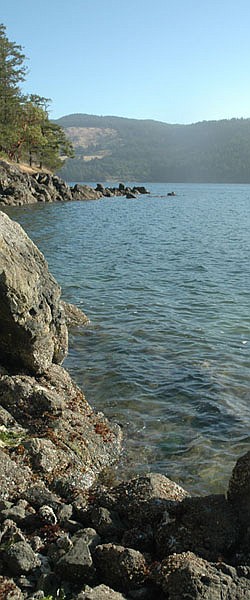The Salish Sea, A Rising Name
August 26, 2014 at 5:50 p.m.
The Pacific Northwest...tall trees, rainy cities, coffee and brilliant waters. When most travelers think of the Northwest, they think of Seattle, Vancouver BC, or just a billowing raincloud.
But unbeknownst to many, the Salish Sea is the proper name for the 300 mile coastline traveling across the border from Canada to the familiar waters of Washington State.
The Salish Sea includes the waters of Puget Sound and beyond: Hood Canal, the Strait of Georgia, the Strait of Juan de Fuca and Desolation Sound, fully defining the Pacific Northwest. The San Juans and Gulf Islands are a beautiful string of islands, easily accessible by ferries from surrounding ports and cities.
The Salish Sea is a rising name in an attempt to gain attention and recognition through such efforts of Salish Sea Tourism and program manager Dave Petrich.
“There’re 120 ports along the Salish Sea, and they all have kind of a common Seaport theme...the northwest style,” Petrich said. “The activities you’d expect are similar; sports, sailing, or bed and breakfasts. If someone is looking for that kind of adventure, we want them to think of the Salish Sea. It’s a bigger subject than a single port.”
In the mid 1970’s, the oil industry was working on plans to come through Washington’s coast on the way back from crude oil discoveries in Alaska. Amid the building of a new factory at Cherry Point north of Bellingham, the oil industry's plans gained the area national recognition in its effort to protect marine life. The efforts also lead for the need of a proper name for the area.
As the area was growing into a recognized ecosystem, in 1989 the proposed name “Salish Sea” was officially submitted by Bert Webber, a retired Western Washington University biology professor.
After years of deliberation, the name “Salish” was chosen for the region, honoring the Coast Salish people who originally lived there.
Salish Sea Tourism is working to benefit travelers of all walks of life, and introducing them to a Pacific Northwest they never knew existed.
The Salish Sea Marine Sanctuary is an organization based on providing the marine ecosystem of the sea a safe, sustainable life and environment to live in.
The goal is to manage water quality and wildlife populations while still allowing for tourism to develop.
“Most people coming here think in terms of coming to a specific destination, like Seattle or Vancouver,” Petrich said. “Specific things that might be seen in the international media. People refer to this area as the Pacific Northwest, very few know the term Salish Sea. It’s a very frenzied concept right now in terms of ‘I want to take a trip to the Pacific Northwest.’ ‘Well, where’s that?’”
The Salish Sea is a long and varied coastline, spreading over 1000 square miles total. Capturing the natural beauty of the northwest, it delivers the coastline feel of a faraway trip, and delivers it right next to vast forests.
From skiing, to boating, to rodeos, the Salish Sea is a slowly but surely developing vacation destination, Petrich said, destined to change the way tourism takes a look at the Pacific Northwest.
“Right now, the tourism focuses are fragmented, since there’s a border going through it,” Petrich said. “So you have the interests in Washington, and a few dominant cities that have their own tourism agendas.”
Cities like Seattle and Vancouver are common destinations for far off travelers, greeting travelers with more than the rain. But the Salish Sea offers a tour of lesser known yet fully northwest cities such as Bellingham, and other destinations along the way.
Bellingham offers the scenic shopping district Fairhaven, founded over 100 years ago, overlooking the nearby sound while the sun hits the sloped town just right.
“We think that there could be another layer on top of that,” Petrich said. “In terms of an overall awareness of the Salish Sea, sort of like the Mediterranean or other multi-port destinations.”
The Salish Sea is a varied location destination fostering its own growth, as the name it makes for itself starts to highlight its features: spas, private boats, small towns, big cities and more: the area has something for everyone.
Whether biking through the sun-lit forests of Chuckanut, or kayaking along the same ridge in the waters below, the Salish Sea offers a stretch of land with both American and Canadian outdoor offerings.
The more the Salish Sea tries to become known, the more people start to think that there really is more to the Northwest -- more than Seattle and Vancouver, more than the forests.
The Salish Sea continues to build itself up as a popular tourist destination, and as it does, the culture, respect, and general knowledge of the area continues to grow in kind.
Salish Sea Tourism is still gaining way for itself, to learn more, visit: http://www.salishseatourism.com/
Puget Sound Magazine has been writing and reviewing Salish Sea locales in-depth for a while, and can be browsed at http://www.pugetsoundmagazine.com.
A full history of the naming of the Salish Sea can be found at http://www.wwu.edu/salishsea/.
Puget Sound Magazine offers a travel blog on the Salish Sea at http://salishseablog.com/. More about the Salish Sea Marine Sanctuary can be learned at: salishsea.org.
Learn more about the Salish Sea Marine Sanctuary & Trail, and the efforts of the Salish Sea Foundation to create North America's first international bioregional marine sanctuary: www.salishsea.org
Seattle-area based native Reed Strong is a college senior at Western Washington University majoring in journalism, working with Northwest Prime Time to talk with local seniors and baby boomers to report on local issues to get those issues back to the community at large.





